We get whisked away at 6.30 in the morning to our next destination, Parque National Torres del Paine. Still in Patagonia but on the Chilean side, it is reputed to be ‘trekker’s heaven’ and South America’s finest national park. Soaring vertically more than 2,000m above the Patagonian steppe, the three granite pillars of Torres del Paine dominate the landscape and must be one of the most photographed natural features on the continent. What they do not tell us until we get there is that the weather pours with rain and wind lashes everything above ground level. For one mad moment we had seriously considered camping for several nights as we circumnavigated the granite massive on foot but hot showers and warm beds had won the day marginally over being wet, bedraggled and miserable.
 And what a sound decision that turned out to be. The weather can change suddenly and without warning: we arrived in wall to wall rain, falling from the sky as if from a power shower but, after lunch, out came the sun and a pleasant, dry afternoon was enjoyed by all. Overnight came the wind, tearing angrily at the corrugated roof and bashing the windows reminding us that we had missed church again. It is said, and we can vouch for its accuracy, that here we will get all four seasons in an hour. In our short time here we experienced everything but the thing that most sticks in the memory is the wind. Indefatigable is the best adjective. It is relentless and gusts with such strength that remaining upright requires total attention especially when walking on a ledge; communication can be made downwind but not the other way. Welcome to the Patagonian wind.
And what a sound decision that turned out to be. The weather can change suddenly and without warning: we arrived in wall to wall rain, falling from the sky as if from a power shower but, after lunch, out came the sun and a pleasant, dry afternoon was enjoyed by all. Overnight came the wind, tearing angrily at the corrugated roof and bashing the windows reminding us that we had missed church again. It is said, and we can vouch for its accuracy, that here we will get all four seasons in an hour. In our short time here we experienced everything but the thing that most sticks in the memory is the wind. Indefatigable is the best adjective. It is relentless and gusts with such strength that remaining upright requires total attention especially when walking on a ledge; communication can be made downwind but not the other way. Welcome to the Patagonian wind.
The hotel we are staying in is perfectly situated in the heart of the park close to all the main walks. There are two big hikes: one that circumvents the massive mountains and takes 8 days and the second that is known as the W circuit that delved into the three valleys within the mountains and takes 4/5 days. We went for the second option because it allowed us to return each night to the sanctuary of the hotel where Debbie could massage my sore limbs and sooth my furrowed brow (another one of those unfulfilled male fantasies).
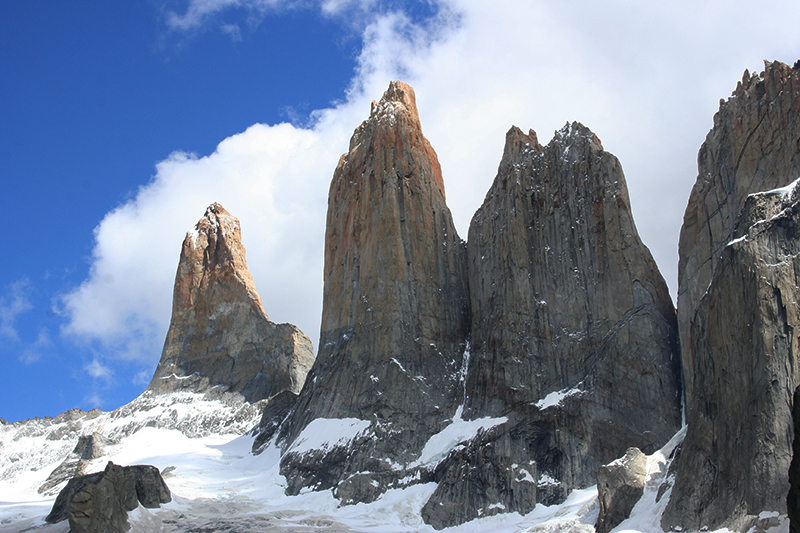 To warm up on arrival we took the easy route to Los Cuernos (& the shortest on the W circuit) alongside a small laguna & Lago Nordenskjold. The first major trek the next day was to the mirador at the base of the towers themselves. We were offered horses to walk us to the first refugio, two hours and 400 metres up the climb but, knowing that would be gutless, we declined and set off on our own telling the guide we would meet him and his gutless horseriders along the route. After two hours we reached the base of the final climb and waited for nearly two hours in the cold wind for the others to catch up. After that we gave up and continued without them, the last 30 minutes being a knee popping scramble over big boulders to reach the viewing point. This is as close as anyone can get without strapping on climbing gear for a vertical ascent of the granite.
To warm up on arrival we took the easy route to Los Cuernos (& the shortest on the W circuit) alongside a small laguna & Lago Nordenskjold. The first major trek the next day was to the mirador at the base of the towers themselves. We were offered horses to walk us to the first refugio, two hours and 400 metres up the climb but, knowing that would be gutless, we declined and set off on our own telling the guide we would meet him and his gutless horseriders along the route. After two hours we reached the base of the final climb and waited for nearly two hours in the cold wind for the others to catch up. After that we gave up and continued without them, the last 30 minutes being a knee popping scramble over big boulders to reach the viewing point. This is as close as anyone can get without strapping on climbing gear for a vertical ascent of the granite.
 The sun came out to display the Torres del Paine in all their glory and we sat, leaning against cold rock, enjoying the most magnificent view in the park. On the way back we passed the others going the other way and were not impressed to discover that our lunch had been left behind as we were considered ‘not on tour’ and without any cash on us, we would have to get back to the hotel before we could eat anything. Despite rumbly stomachs, the walk back was wonderful and, other than the wind that blew over some other trekkers, was uneventful. It transpired that the horseriders did not return until 8.30 in the evening having taken 5 hours longer than us to cover the same ground. Thank goodness we avoided them; we would have been tearing our hair out!
The sun came out to display the Torres del Paine in all their glory and we sat, leaning against cold rock, enjoying the most magnificent view in the park. On the way back we passed the others going the other way and were not impressed to discover that our lunch had been left behind as we were considered ‘not on tour’ and without any cash on us, we would have to get back to the hotel before we could eat anything. Despite rumbly stomachs, the walk back was wonderful and, other than the wind that blew over some other trekkers, was uneventful. It transpired that the horseriders did not return until 8.30 in the evening having taken 5 hours longer than us to cover the same ground. Thank goodness we avoided them; we would have been tearing our hair out!
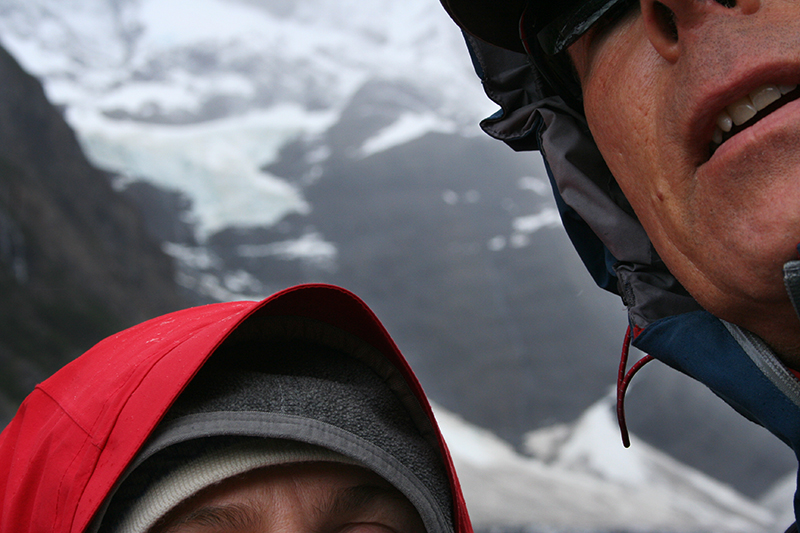 Next up was the Valle Frances that involved a car journey and a boat trip to get to the start of the hike that follows the shoreline of Lago Pehoe before turning into the valley that cuts into the mountains alongside Los Cuernos, behind yesterday’s Torres del Paine. This time we made sure that we carried our lunch with us and we were in a guided group. This was a slow walk with the guide stopping frequently to lecture on the flora along the way; especially the edible dark berries of Calafate that we were made to eat as if they were some kind of delicacy. But the walk was excellent, taking in azure lakes, emerald forests and roaring rivers that we crossed on rickety bridges before being confronted with a glacial slab of ice. We sat down and took lunch, donning all our clothing against the strong cold wind and enjoyed the spectacle of Glacier Frances. After eating, the rest of the group turned back but, with time in hand, we pressed on up the valley. This turned out to be not such a good idea as the rain began to lash down and the trail became a streaming torrent of water. We found ourselves scrambling over wet rock and jumping over newly formed rivers that use to be trails and progress was slow. So after 45 minutes we turned back and made the last ferry with 20 minutes to spare.
Next up was the Valle Frances that involved a car journey and a boat trip to get to the start of the hike that follows the shoreline of Lago Pehoe before turning into the valley that cuts into the mountains alongside Los Cuernos, behind yesterday’s Torres del Paine. This time we made sure that we carried our lunch with us and we were in a guided group. This was a slow walk with the guide stopping frequently to lecture on the flora along the way; especially the edible dark berries of Calafate that we were made to eat as if they were some kind of delicacy. But the walk was excellent, taking in azure lakes, emerald forests and roaring rivers that we crossed on rickety bridges before being confronted with a glacial slab of ice. We sat down and took lunch, donning all our clothing against the strong cold wind and enjoyed the spectacle of Glacier Frances. After eating, the rest of the group turned back but, with time in hand, we pressed on up the valley. This turned out to be not such a good idea as the rain began to lash down and the trail became a streaming torrent of water. We found ourselves scrambling over wet rock and jumping over newly formed rivers that use to be trails and progress was slow. So after 45 minutes we turned back and made the last ferry with 20 minutes to spare.
The final leg of the W was the longest trek; around 24 km up Largo Grey to the base of the Grey Glacier. This time we left the guides behind and they clearly thought we would not have sufficient time to complete the trek and get back for the last ferry so we set off at a brisk pace. It turned out to be the most beautiful walk of the three with glorious views of the lake and the glacier for the second third of the trip. Thereafter, we wandered through forests and over streams and waterfalls until we emerged in front of the glacier. Had the sun been out and the wind gone away, we would have had a slothful picnic sitting on the rocky outcrop at the head of the lake but the Patagonian wind finally got the better of us and we retreated into the woods soon after we finished our sandwich. Having plenty of time, we wandered back, taking our time over photographs, enjoying the views and trying to nurse sore knees home. Going uphill is not the problem; it’s the downhill (particularly steep downhill) sections that are the killer. My knees hurt and are swollen and, instead of my natural, easy, athletic gait, I now resemble a robot walking. My partner gives me no sympathy – her feet hurt. Enough of this trekking malarkey, I need to stop before I have to kill someone for spare body parts.
As usual, I find the best medication for oiling creaking body parts is a good stiff drink. We start with Pisco Sours but when I see the barman making them with powder instead of liquor from a bottle a swift change of plan becomes imperative. Back to the G&Ts double quick.
On our last morning, Debbie wrangles a horseride out of the hotel. Horses in this part of the world are dirt cheap and it’s possible to buy two horses here for the price of a cat back home (not that any sane person would buy a cat anyway). Consequently, they are not treated particularly well and get very jumpy when one of the gauchos starts whistling or hollering. They took one look at me and assigned me the largest carthorse-like beast. Together, we struggled up the slippery slopes and I was glad that she always had three feet on the ground at any one time. Some of the trail along ridges with sheer drops to one side were particularly alarming, one slip and we would be dead meat heading for the glue factory, but I consoled myself with the thought that no horse had been known, as yet, to have committed suicide. However, from the top of the hills, the views over the parkland were magnificent and worth every ounce of horse sweat. The sun was out, the rain had gone, the wind had stopped and we could believe that summer truly had come to Patagonia for a day and all was well with the world. A glorious way to finish our time in the park.


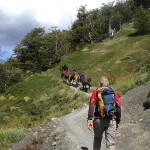







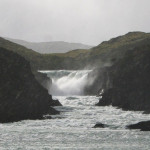


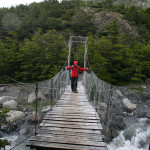




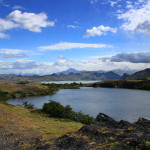

No comments yet.